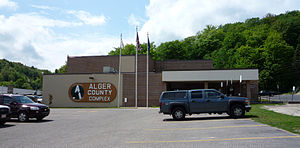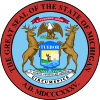Alger County, Michigan
Alger County | |
|---|---|
U.S. county | |
 Alger County Courthouse Complex, Munising (2009) | |
 Seal | |
 Location within the U.S. state of Michigan | |
 Michigan's location within the U.S. | |
| Coordinates: 47°10′N 86°29′W / 47.16°N 86.48°W | |
| Country | |
| State | |
| Founded | March 17, 1885[1] |
| Named for | Russell A. Alger |
| Seat | Munising |
| Largest city | Munising |
| Area | |
| • Total | 5,048 sq mi (13,070 km2) |
| • Land | 915 sq mi (2,370 km2) |
| • Water | 4,133 sq mi (10,700 km2) 82%% |
| Population | |
| • Estimate (2018) | 9,097 |
| • Density | 10/sq mi (4/km2) |
| Time zone | UTC−5 (Eastern) |
| • Summer (DST) | UTC−4 (EDT) |
| Congressional district | 1st |
| Website | https://www.algercounty.gov/ |
Alger County is a county in the Upper Peninsula of the U.S. state of Michigan. As of the 2010 census, the population was 9,601.[2] Its county seat is Munising.[3] The Pictured Rocks National Lakeshore is located within the county.
History[]
Alger County was detached from Schoolcraft County, set off and organized in 1885. The county was named for lumber baron Russell Alexander Alger, who was elected as a Michigan Governor, and US Senator, and appointed as US Secretary of War during the William McKinley Presidential administration.[1] See also, List of Michigan county name etymologies, List of Michigan counties, and List of abolished U.S. counties.
Geography[]
According to the U.S. Census Bureau, the county has a total area of 5,048 square miles (13,070 km2), of which 915 square miles (2,370 km2) is land and 4,133 square miles (10,700 km2) (82%) is water.[4] It is the second-largest county in Michigan by total area, mainly because of Lake Superior on the north side of the county.
Highways[]
 US 41
US 41 M-28
M-28 M-67
M-67 M-77
M-77 M-94
M-94 H-01
H-01 H-03
H-03 H-05
H-05 H-11
H-11 H-13
H-13 H-15
H-15 H-44
H-44 H-52
H-52 H-58, passes through Pictured Rocks National Lakeshore.
H-58, passes through Pictured Rocks National Lakeshore. FFH 13
FFH 13
Adjacent counties[]
- Luce County – east
- Schoolcraft County – southeast
- Delta County – south
- Marquette County – west
- Thunder Bay District, Ontario – north
National protected areas[]

- Grand Island National Recreation Area
- Hiawatha National Forest (part)
- Pictured Rocks National Lakeshore
Demographics[]
| Historical population | |||
|---|---|---|---|
| Census | Pop. | %± | |
| 1890 | 1,238 | — | |
| 1900 | 5,868 | 374.0% | |
| 1910 | 7,675 | 30.8% | |
| 1920 | 9,983 | 30.1% | |
| 1930 | 9,327 | −6.6% | |
| 1940 | 10,167 | 9.0% | |
| 1950 | 10,007 | −1.6% | |
| 1960 | 9,250 | −7.6% | |
| 1970 | 8,568 | −7.4% | |
| 1980 | 9,225 | 7.7% | |
| 1990 | 8,972 | −2.7% | |
| 2000 | 9,862 | 9.9% | |
| 2010 | 9,601 | −2.6% | |
| 2018 (est.) | 9,097 | [5] | −5.2% |
| US Decennial Census[6] 1790-1960[7] 1900-1990[8] 1990-2000[9] 2010-2018[2] | |||
The 2010 United States Census[10] indicates Alger County had a population of 9,601. This decrease of 261 people from the 2000 United States Census represents a 2.6% population decrease. In 2010 there were 3,898 households and 2,479 families residing in the county. The population density was 11 inhabitants per square mile (4.2/km2). There were 6,554 housing units at an average density of 7 per square mile (3/km2). The racial makeup of the county was 86.3% White, 6.4% Black or African American, 4.1% Native American, 0.3% Asian, 0.1% of some other race and 2.7% of two or more races. 1.2% were Hispanic or Latino (of any race).
Regarding specific ethnicities, 15.7% of the population was of German heritage, 13.5% Finnish, 12.6% French, French Canadian or Cajun, 9.3% English, 7.3% Polish, 6.9% Irish and 5.3% American ancestry.[11]
There were 3,898 households, out of which 20.1% had children under the age of 18 living with them, 52.2% were married couples living together, 7.1% had a female householder with no husband present, and 36.4% were non-families. 31.6% of all households were made up of individuals, and 15.2% had someone living alone who was 65 years of age or older. The average household size was 2.2 and the average family size was 2.74.
In the county, the population was spread out, with 17.1% under the age of 18, 6.6% from 18 to 24, 22.8% from 25 to 44, 32.8% from 45 to 64, and 20.7% who were 65 years of age or older. The median age was 47.3 years. The population was 54.4% male and 45.6% female.
The median income for a household in the county was $38,231, and the median income for a family was $46,154. The per capita income for the county was $19,858. About 9.3% of people in families and 14.0% of the population were below the poverty line, including 19.3% of those under age 18 and 8.2% of those age 65 or over.
Government[]
The county government operates the jail, maintains rural roads, operates local courts, records deeds, mortgages, and vital records, administers public health regulations, and participates with the state in the provision of welfare and other social services. The county board of commissioners controls the budget and has limited authority to make laws or ordinances. In Michigan, most local government functions — police and fire, building and zoning, tax assessment, street maintenance, etc. — are the responsibility of individual cities and townships.
Communities[]

City[]
- Munising (county seat)
Village[]
Civil townships[]
Unincorporated communities[]
- Au Train
- Christmas
- Coalwood
- Deerton
- Diffin
- Dixon
- Dorsey
- Doty
- Eben Junction
- Evelyn
- Forest Lake
- Grand Marais
- Green Haven
- Indian Town
- Juniper
- Kentucky
- Kiva
- Ladoga
- Limestone
- Mantila Camp
- Melstrand
- Munising Junction
- Myren
- Onota
- Rock River
- Rumely
- Sand River
- Shingleton
- Slapneck
- Star
- Stillman
- Sullivans Landing
- Sundell
- Sunrise Landing
- Traunik
- Trenary
- Vail
- Van Meer
- Wetmore
- Williams Crossing
- Williams Landing
- Winters
Indian reservations[]
- Alger County contains two very small portions of the Sault Tribe of Chippewa Indians tribal community, which is headquartered in Sault Ste. Marie in Chippewa County. One portion is in the northeastern corner of Au Train Township, and another slightly larger portion is about two miles south of Munising in Munising Township.[12]
Politics[]
Alger County was reliably Republican from the beginning through 1928. Since then it has voted for the Democratic nominee 65% (15 of 23) of the time.
See also[]
- List of Michigan State Historic Sites in Alger County, Michigan
- National Register of Historic Places listings in Alger County, Michigan
References[]
- ^ Jump up to: a b "Bibliography on Alger County". Clarke Historical Library, Central Michigan University. Retrieved July 2, 2013.
- ^ Jump up to: a b "State & County QuickFacts". US Census Bureau. Archived from the original on June 6, 2011. Retrieved August 26, 2013.
- ^ "Find a County". National Association of Counties. Archived from the original on May 31, 2011. Retrieved June 7, 2011.
- ^ "2010 Census Gazetteer Files". US Census Bureau. August 22, 2012. Archived from the original on November 13, 2013. Retrieved September 18, 2014.
- ^ "Population and Housing Unit Estimates". Retrieved May 16, 2019.
- ^ "US Decennial Census". US Census Bureau. Retrieved September 18, 2014.
- ^ "Historical Census Browser". University of Virginia Library. Retrieved September 18, 2014.
- ^ "Population of Counties by Decennial Census: 1900 to 1990". US Census Bureau. Retrieved September 18, 2014.
- ^ "Census 2000 PHC-T-4. Ranking Tables for Counties: 1990 and 2000" (PDF). US Census Bureau. Retrieved September 18, 2014.
- ^ "U.S. Census website". Retrieved July 6, 2013.
- ^ "U.S. Census website".
- ^ United States Census Bureau (2000). "Michigan County Subdivision Outline Map" (PDF). Retrieved April 13, 2018.
- ^ Leip, David. "Dave Leip's Atlas of US Presidential Elections". uselectionatlas.org. Retrieved April 8, 2018.
External links[]
- Alger County Online
- Greater Munising Bay Partnership for Commerce Development & Alger County Chamber
- National Association of Counties - Alger County, MI
- Alger County Sheriff's Office
- US Coast Guard Auxiliary Flotilla 26-12
- "Bibliography on Alger County". Clarke Historical Library, Central Michigan University. Retrieved July 2, 2013.
- Michigan counties
- Alger County, Michigan
- Populated places established in 1885
- 1885 establishments in Michigan


